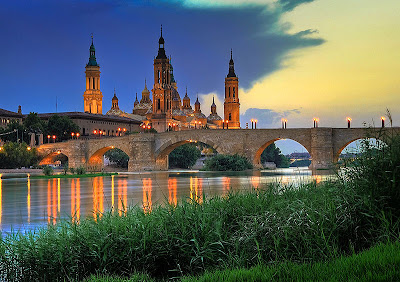 |
Basilica del Pilar
Photo: Wikipedia |
Zaragoza was one of the most beautiful places I went to in Spain. It was a town I had never heard of - and of course there are millions of beautiful places I haven't heard of but that is why I am on a mission to search them out - one of my brothers had read about it and recommended we go, I was like "sure" but had no idea what I was about to experience... I am so thankful he took us there!!
Zaragoza is the capital city of the Zaragoza Province and of the autonomous community of Aragon, Spain (there are 50 provinces in Spain, maybe we can equate them to states?). The river you see in the picture above is the Ebro River, this city covers a variety of landscape from desert (Los Monegros) to thick forest, meadows and mountains. It's just gorgeous...
So, the city was amazing!!! It is famous for its folklore, its food and landmarks such as the Basilica del Pilar, La Seo Cathedral and The Aljaferia Palace.
 |
La Seo Cathedral
Photo: Wikipedia |
 |
Aljaferia Palace at night, built in the 11th century
Photo: Wikipedia |
As destiny would have it we arrived during the Fiestas del Pilar - only among the most celebrated festivals in Spain. So, a bit more background...
Basilica del Pilar - (In English the Basilica-Cathedral of Our Lady of the Pillar) is a Roman Catholic Church that venerates the Blessed Virgin Mary. Our Lady of the Pillar was praised as the Mother of the Hispanic People by Pope John Paul II. It is the first church dedicated to Mary in history so it is a pretty big deal.
According to tradition St James was preaching in Spain shortly after Jesus was crucified and was disheartened because of the failure of his mission. But on January 2, 40 AD, while deep in prayer Mary appeared to him and gave him a small wooded statue of herself and a column of jasper and instructed him to build a church in her honor. "This place is to be my house, and this image and column shall be the title and altar of the temple that you shall build". The rest as they say is history... The current building was built from 1681 - 1872 and is incredibly beautiful. If you have some time, read more about this basilica, the history is very interesting, including the fact that during the Spanish Civil War (1936 - 1939) three bombs were dropped on the church and none of them exploded. Two are still on display at the basilica.
Fiestas del Pilar - (The feast of Our Lady of the Pillar) celebrates the first apparition to Mary to Hispanic people. This coincides with the date of Columbus' discovery of the New World. We ventured out at 11pm, which is about when people head out for dinner in Spain. Once we neared the Basilica we saw thousands of people, it was like Mardi Gras in New Orleans - my hometown - so I was excited at the energy and the crowds. But this was very different than Mardi Gras; here every age was out in celebration until early in the morning. Then people were out again at 7:30am to start the more traditional and religious part of the festival - well not everyone was up that early but the majority of people... this festival is taken very seriously and it was amazing.
 |
The festival was one of the highlights of my trip - by far!!
Thanks to my brother :-) |
 |
It was incredible the vast number of people that dressed in traditional clothing
for the festivities, from infants to the elderly. It was beautiful to see. With
all the globalization going on we sometimes forget where we are,
in this town, on these days I had no doubt that I was in the heart of SPAIN !! |
The one thing we missed was the Rosario de Cristal (Rosary of Glass), a parade celebrating the rosary and made of glass - next time!!
 |
| Photo: concursofoto.edreams.es |













































